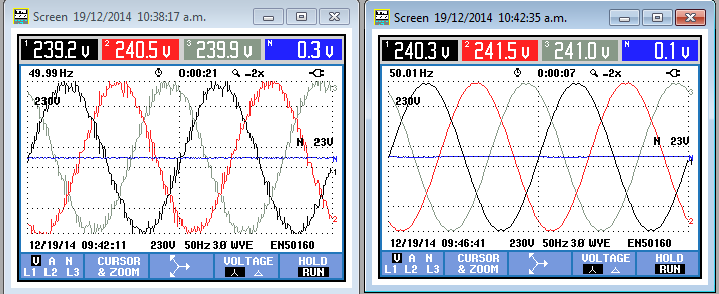
Active Filters
Series Active Filters - Active Front End Drives.
An active rectifier within the VFD can be designed to ensure sinusoidal current draw from the supply ensuring that the harmonic currents are low. This can be referred to as a "low harmonic drive". The active rectifier is made up of the same components as the output of a VFD plus a switching filter. The cost of the active front end drive is close to couble the cost of a standard VFD. In some cases, the active front end VFD is made up by using a reverse connected VFD with special software.
The Active switching rectifier is PWM controlled at a switching frequency that is well above the fundimental frequency, typically between 1.5KHz and 20KHz. This produces a "common mode" current that is fed back into the supply.
Between the switching devices, and the supply, there are usually two filters, one is an EMC filter designed to attenuate the magnitude of switching currents above 100KHz and the other is designed to attenuate the common mode switching currents. The main switching filter is usually referred to as an LCL filter as it is made up of both inductors (L) and capacitors (C).
The attenuation of the common mode current is a function of the LCL filter and the impedance of the supply at the frequency of the common mode current. As the switching frequency of the active stage is increased, the frequency of the common mode voltage is also increased. The Attenuation of the LCL filter normally increases with frequency, but the impedance of the supply also increases with frequency.
The common mode voltage amplitude is a function of the common mode current generated by the AFE and passed through the LCL filter into the impedance of the supply. A high current will increase the voltage as will a high impedance.
Operation of Active Front End drives (AFE) in very strong supply regions, (very high prospective fault current) will usually have a very low impedance and therefore the common mode voltage induced on the supply voltage will be low.
Shunt Active Filters
Active filters are essentially an inverter with the output coupled back into the supply. The active filter is designed to measure the harmonic current present in the load and to generate a negative harmonic to cancel the harmonics produced by the load. At present, active filters are expensive but are reducing in cost and will become a much more viable technology with time. Active filters are also able to provide displacement power factor correction and thus are a true power factor correction device, correcting both displacement power factor and distortion power factor. Being an active system, instability can be an issue with active filters, but generally this is not a problem.
The PWM output of the active filter is fed back to the Supply via an LCL filter (as used for the AFE) and there will be a common mode voltage induced which is a function of the common mode current and the supply impedance at that frequency. Operation in very low impedance supplies will result in reduced common mode voltages induced onto the supply voiltage.
Active Filters on High impedance supplies
The active filter is essentially a power inverter using PWM technology to draw current from, and generate current to the supply in a manner that reduces the distortion on the current waveform. The PWM waveform is passed through an LCL filter to reduce the high frequency component of the filter, but inevitably, there remains a high frequency ripple component in the current applied back to the supply.
In a very low impedance industrial supply, the effect of this ripple current is small, however in a high impedance supply as coomonly found on the rural network, the ripple current will reflect onto the supply as a ripple voltage. (This is true on any supply, but if the Z at the frequency of the ripple current is very low, the ripple voltage will also be very low. v = i x z)
In installations with long overhead lines will have a high inductance and this will dramatically increase the ripple voltage superimposed on the local network voltage.
In some cases, the amplitude of the ripple voltage is many times the amplitude of the harmonic voltage that the filter is being used to reduce, but because the frequency of the ripple voltage is many times the typical harmonic voltages produced by VFDs, it is not measured by typical Power Quality meters.
Hi voltages at frequencies above the standard harmonic frequencies can be more damaging to other connected equipment because the peak currents through any capacitove circuits will be much higher.
Weighted harmonic voltages tend to give a greater indication of the potential damage that can be caused on the supply.

Comparison of Voltage waveform with and without filter running as measured with a Fluke PQ meter.
|
|
|